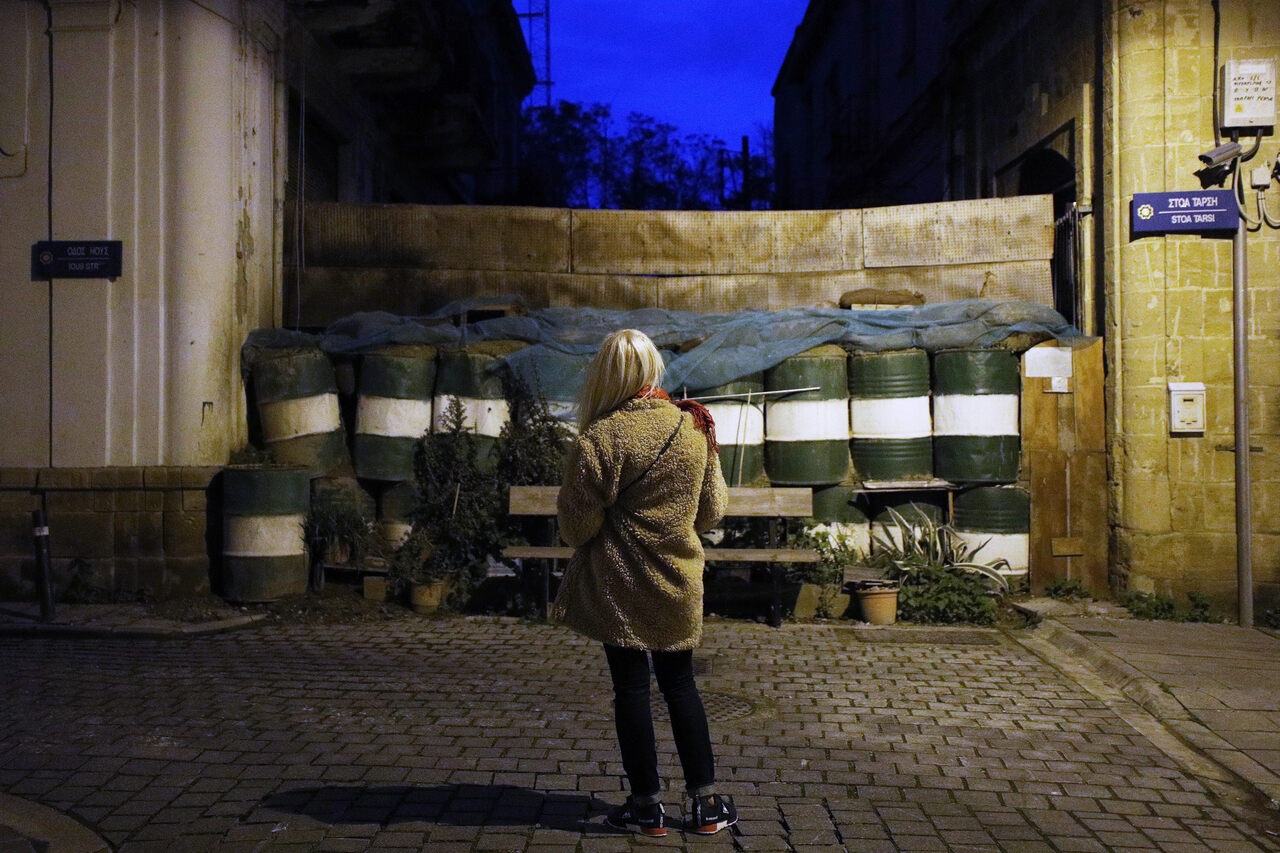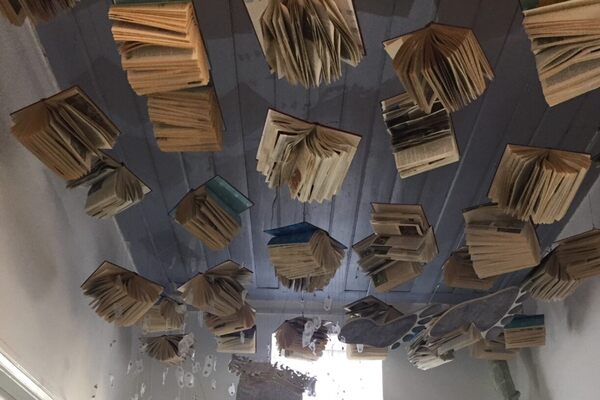Life Along the Border That Cuts Cyprus in Two
In Nicosia, physical barriers separate the Greek
and Turkish communities—but many residents
don’t seem to mind.
A SHARP LINE CUTS ACROSS the island of Cyprus. It runs through the middle of Nicosia, the capital, marked by stacked barrels, makeshift walls, and barbed wire. Soldiers in camouflage stand guard behind the barricades, and the letters “UN” loom in thick black letters on various buildings. To an outsider, this border within a country may feel like the markings of a battleground, but the city is not at war. The line through Nicosia exists to separate the city’s Turkish and Greek ethnic communities.
Just south of the stacked barrels and blocked roads, on the Greek side of town, a store called Phaneromenis 70 sells local artworks and serves as a kind of creative nucleus for Nicosia. Monika Ioakim, a DJ and associate of the Phaneromenis 70 collective, has seen this corner of Nicosia transform during her 48 years. “When I was growing up, we were told not to go too close to the border for fear of being shot or stepping on a landmine,” she says. “There was a lot of fear.”
Today, the border is little more than a formality. A civilian can cross to the other side by flashing a passport at Nicosia’s Ledra Street checkpoint. But the history of the border that divides Cyprus is long and troubling, and it haunts the city to this day.

Cyprus experienced almost eight centuries of foreign control, first under King Richard I of England and then the Knights Templar, the French family of Lusignan, the Venetians, and the Ottomans, whose descendants are Turkish Cypriots. The British returned in 1878 as the last in this chain of invaders, and they ruled the island for approximately 80 years. During that time, Cypriots grew resentful. Roughly 80 percent of the population identified as Greek Cypriots and believed that Cyprus belonged to Greece.
Between 1955 and 1959, a Greek Cypriot guerilla group called E.O.K.A. fought for enosis, or political union with Greece. In 1960, Britain withdrew from Cyprus—but rather than unification with Greece, Cyprus was given independence. “After such a long time of foreign rule, they had no idea how to react to independence,” says Andreas Karyos, a historian at the National Struggle Museum in Nicosia.
After the British left, the island’s Turkish and Greek communities struggled to trust one another as they grappled with the strange, new concept of freedom. “Once the constitution was created, it was difficult to implement because the law was interpreted differently by the Greek Cypriots and the Turkish Cypriots,” explains Karyos. The national constitution stated that Turkish and Greek authorities could only rule over their respective ethnic populations. Yet the constitution did not specify how to determine the boundaries between Turkish and Greek Cypriot populations.

These disagreements only grew. Turkish Cypriots were granted 30 percent representation in all civil service posts, which was larger than their 18 percent share of the island’s population. The constitution called for a joint army, but the disparate groups couldn’t agree on how to form one. The Turkish and Greek Cypriots were supposed to form a mutual system of tax legislation, but they could not agree on this either. “Only one spark was necessary to destroy everything,” Karyos states. “And this is exactly what happened.”
In late 1963, Cyprus descended into sporadic, intercommunal violence that would culminate in the partition of the island. On July 15, 1974, the Greek government backed a military coup to support a new, pro-Greece leader of Cyprus. Turkey reacted five days later by invading. Approximately 9,000 people died in the fighting. Eventually, the United Nations intervened and established the Green Line, a buffer zone that separates the island into two ethnic halves.

Locals still live with the effects of the city’s partition. Nicosia is both the capital of Cyprus and its only divided city. In the southern half of the historic center, which is predominantly Greek, a Greek Cypriot businesswoman named Eleni Michaelides runs a textile shop. Her father, Andreas, founded it in the 1960s, when he was only 29. “It was very difficult at the time, because most of the textile shops then were not here,” she says. “They were on Ermou Street.” (Ermou Street weaves between the UN Buffer Zone and the Turkish half of Nicosia.)
When Andreas built his shop in a different area of Nicosia, on Onasagorou Street, his peers had their doubts. But the store thrived, and other textile merchants followed. “It was a good thing for all of us, because if we would have stayed on Ermou Street, we would have lost our businesses,” explains Michaelides.
Many Cypriots can relate. In 1974, people of Greek descent with homes or businesses in northern Cyprus were forced to relocate to the south. Conversely, Turkish Cypriots who lived in the south were forced to move north. Civilians were barred from visiting the opposite side of the island until 2003, when public checkpoints were established.

Ioakim’s family experienced the division first-hand. Her parents were originally from the eastern town of Famagusta, but Turkey’s invasion forced them to relocate to the Greek half of Nicosia when she was four. Ioakim spent many years abroad as a DJ, and when she returned in 2016, she had mixed feelings about the border.
“It was harder for me to accept and let go, because both of my parents are refugees,” Ioakim says. “The border opened when I was living abroad. When I came back, it was an everyday thing. It took me a while before I realized it was fine.”
Ioakim says that crossing the border can be painful for older generations, because the other side of the island contains relics of what they lost. Her mother has only been to the Turkish side twice since the border opened, to visit the home she inhabited before 1974. “For us and the younger generation, it’s different,” Ioakim says. “If you don’t have the emotional attachment, it’s fine. Just people getting on with their lives on both sides.”

Cagla Elektrikci, a friend of Ioakim who is in her early thirties, grew up on the other side of the border, in northern Nicosia. She is the granddaughter of Turkish Cypriots who were uprooted from the southern cities of Larnaca and Paphos. Today, her life bridges the divide; she works and studies on the Greek side of Nicosia. “I cross the border almost every day to work, to study, to travel, to shop, and to connect with my friends and colleagues in both communities,” Elektrikci says.
Elektrikci is proud to live in a place with such diversity and history, but she hopes that the border will not last forever.



No comments:
Post a Comment